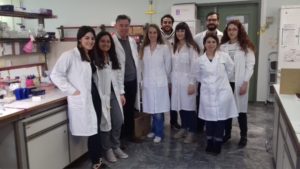2020 Innovator Award Series: Get to Know Dr. Stavros Taraviras
In January, we announced our 2020 Innovator Award grantees. The Innovator Award is designed to provide seed funding for bold and innovative work with the potential to transform hydrocephalus research. In this installment of our Meet the Innovator Award Grantees Blog Series, we interviewed Dr. Stavros Taraviras, one of four scientists who received a 2020 Innovator Award. Dr. Taraviras is a Professor in the Department of Physiology at the Medical School, University of Patras in Greece. Dr. Taraviras is working to reprogram scar tissue into functioning ependyma, the cells that line the ventricles in the brain. In many forms of hydrocephalus, ependymal cells are damaged and fall into the cerebrospinal fluid (CSF). Scar tissue replaces the ependyma. This treatment could reduce ventricle size and improve CSF movement, brain development, and brain health.
What sparked your interest in hydrocephalus research?
Our research was initiated by trying to understand how cells in the brain are formed: which are the molecular cues that control the generation of different cell types in the brain. We gradually focused on ependymal cells, the cells that line the brain ventricles and are essential for brain function and homeostasis. We identified genes that are key for initiating the path leading to the generation of ependymal cells. Moreover, genetically modified animal models that we generated showed the involvement of these genes in the pathophysiology of hydrocephalus.
Studying both normal physiology (the molecular events that generate ependymal cells) and the pathophysiology of the disease through our hydrocephalic animal models, we thought to mimic the molecular events taking place during development, aiming to generate functional ependymal cells in the hydrocephalic brain. In hydrocephalus, ependymal cells are often damaged, leaving behind scar tissue. We are suggesting turning this scar tissue back into ependymal cells as a novel therapeutic strategy for human hydrocephalus.
How long have you been researching hydrocephalus?
We have been researching hydrocephalus in basic and applied research for about 10 years.
What is the goal of your research funded by the Innovator Award Grant? What questions do you hope your research will answer?
We know that ependymal cells are somehow affected or damaged in patients with hydrocephalus so our goal is to find a way to regenerate them and make them functional again. Subsequently we would like to examine whether these “regenerated” cells can help ameliorate brain enlargement, CSF circulation and neurogenesis defects observed in mouse models with hydrocephalus. So the idea is to generate new functional cells by mimicking the pathways that drive the generation of ependymal cells during development. Our long-term goal is to provide evidence for novel therapeutic approaches in patients suffering from hydrocephalus.
What makes your project unique?
It is the first time that reprogramming of scar tissue into functional ependymal cells has been suggested and this is based on previous findings from my lab describing the molecular events that drive the generation of these cells in normal development. As gene transferring approaches are coming closer to clinical practice, we believe that our findings might provide a therapeutic alternative for hydrocephalus patients in the future.
How important is HA’s Innovator Award grant for your project?
It is definitely very important. The funds provided by the Hydrocephalus Association will permit us to perform the initial experiments and set the basis for our hypothesis. In addition, and very importantly, the distinction conferred by the HA Innovator Award, together with new findings which we will generate through this grant, will allow us to seek further funding and pursue this promising line of research in the future. The networking provided by this grant is also important. The Hydrocephalus Association will play an important role in helping us bring this research closer to patient use.
What are the next steps?
The results up to now are encouraging. Currently, our experiments are performed in diseased cells and animal models. We are now planning the next step, which will require us to translate our findings into therapeutic interventions for humans. That will take a collaborative effort and I believe the Hydrocephalus Association can be of great assistance for these next steps.

